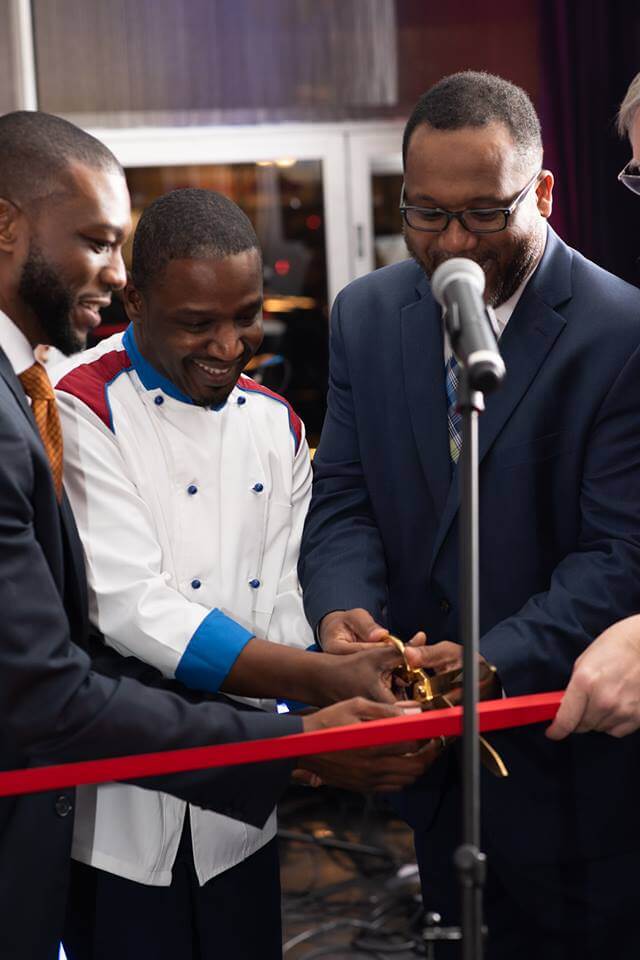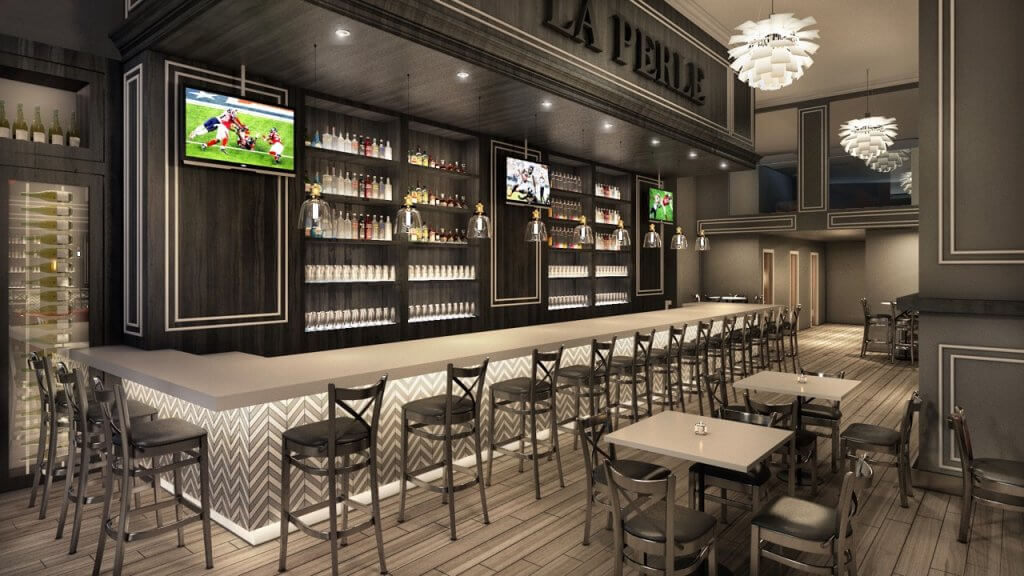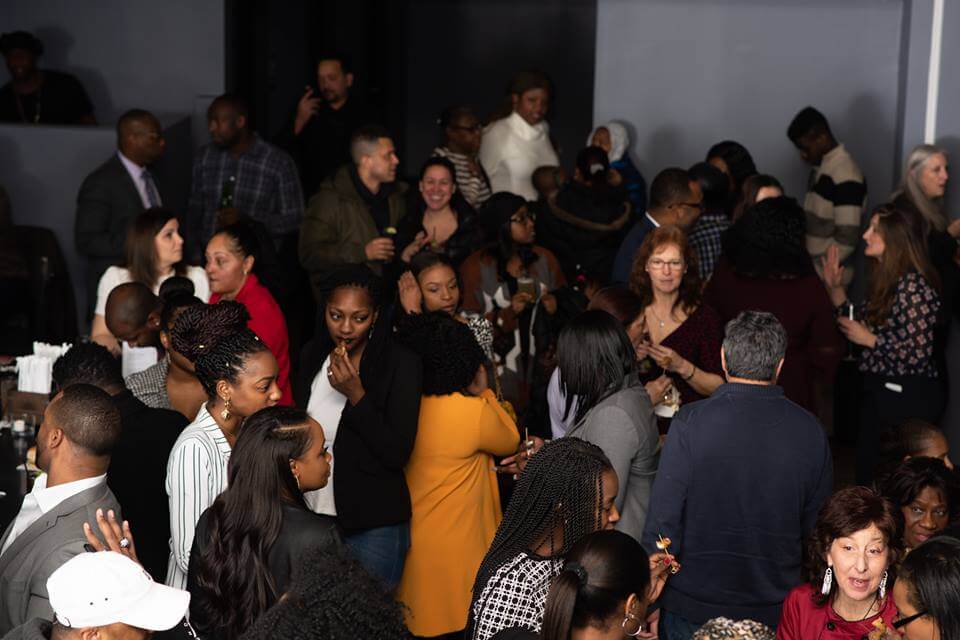
Haitian cousins Chef Smith St. Juste and Peter

Style & Vibes: So tell me a little bit about how you two met and like what your partnership is in general?
Smith: We’re cousins, grew up together, we’ve always been close. We’ve never been too far from each other. We can’t see things the same but at the same time, different perspective. We don’t argue but we have deep conversations.
Peter: When we first got back from college, we did have a vision of creating something like we’re creating now. It wasn’t the right time, even though we had this grandiose idea of creating something like this at Stamford because we always knew that it needed it and we kept looking around for someone to create it and once we realized that someone else wasn’t going to create it, we just thought, “Hey, listen, if no one’s going to do it, why don’t we do it?”
S&V: So, tell me a little bit about your Caribbean background and how that kind of plays into the restaurant itself.
Smith: I’m Haitian, a proud Haitian.
Peter: I am as well.
Smith: Since 1804! (Laughs) (1804 is the year Haiti gained independence from France, Haiti is known as the first free Black Republic in the Americas)
We’re Haitian, we grew up in with a strict family, with great family values. Our family was one with great work ethic and education. We weren’t too happy with how strict our parents were. We saw what other kids are doing, we thought that at the time, “Hey, we should be doing it too,” but now we thank them, you know, for who we are.

Peter: Our parents sort of laid it down to us that both Smith and I, we didn’t have an option not to go to college, and the way we grew up, we knew that we wanted to do it anyway. We both
Smith: I knew what I wanted to do since I was 16 and Peter knew where he wanted to do probably when he was like 14 years old and we never strayed away from that. We always been true to ourselves. I always look at food as an art. In architecture, we bring to the design. The art part of it is like a good marriage.
S&V: A lot of people don’t know, there’s a huge Haitian community here, there’s a huge Jamaican community here, there’s a huge Latino community here and we grew up around the same time. How important is it to build it here?
Peter: Well, I think culture is very important for us. We grew up in an era where it was a very big thing for us being Haitian because it was a very turbulent time. But over the course of time, I think the city has just changed by so much.
Living in New York City, I’d just see the growth of everything going on and then I come here, and it’s like, it’s dead, right? And then the conversation that Smith and I always have is, “Hey, you know, what’s going on in Stamford?” it’s nothing.
We wanted to have that inclusiveness of all these different cultures at the same time, still feeling like you’re still back home.”
So for us, it was one of those things where it’s like, why is it that whenever a minority wants to do something, go somewhere, have a business, we can’t find anything? A place to sit down, or you have family or friends that are here that like, “Hey, what’s a good restaurant?” Whether you want to have a meeting, have a family friend that’s in town, whether it’s brunch, where it’s going to be lively, like you’re going to literally feel like you’re in the city with our
Smith: Yeah, I mean, we wanted to do it in this city because, for one, there was an opportunity for us. There is a market for us, young professional Caribbean people that live here, movers and shakers in the city that we don’t have a place of our own.

Peter: Also, people love going to the Caribbean. It’s like, “Oh my God, I went to Aruba, I had this (food,)” but it It’s only when they go there that they talk about it right? But what about when they’re here? They can’t find that. So that’s another reason why we’re not create a one size fits all type, but something that can sort of fit almost every palate. We’re going to feature something from every Caribbean island throughout the year and that was our main concept of why we came up with this particular.
S&V: What were some of the challenges that you guys have kind of come up against, if there are any.
Peter: I think there’s a ton of challenges. But very early on we realized there are bureaucratic wall blocks, every step of the way, there are financial roadblocks across the board. The space that we got wasn’t a brand new building. If that was the case, it would have been easy. You don’t want people to have the mindset, “Oh, I’m going right back to that space.” you want it to be something where people feel as soon as they walk in, it’s a completely different space, you know?
Smith: Yeah, the financial roadblock. People with that previously said to us, “Whenever you guys decide to open this restaurant, let us know we will be more than happy to invest.” The one thing we believe in, we believe in loyalty. We thought that we needed to reach out to these people, come to find out it was all talk.
We had to be ready on our own and we thought that we were ready for this project and that’s the reason we took this project, and anybody else that wanted to come on, you know, later on, it was kind of like, too late. Peter and I

Peter: Yeah, I mean, I think one of the advantages that we’ve had is that if both of us were in the same career path, I feel that would have hit a lot more challenges. The fact that he’s been in the food industry for so long, there’s a lot of things that I’ve learned from him along the way Me, being an architect a lot of challenges that other people would run into in the building industry, or going through the building department, most we resolved just because of relationships that I’ve had working in the city, and just different challenges that I’ve kind of worked through with other people. So I think most of the challenges we’ve dealt with was just similar challenges to anyone opening up a new business, you know, because everyone thinks it’s easy and then once you really get into it.
S&V: Tell me about your maybe a week or so away from opening, how do you guys feel right now? What are your expectations?
Peter: We’re excited and, you know, I think we’re excited for a lot of different reasons. We’ve always felt like Stamford was missing us and for us, we feel like we’re finally giving the city something that people have been asking for and at the end of the day, like, we joke around, like, “We’re finally giving people what they want, let see if they’re going to show up.” you know, because that’s the big thing. We know that not everything is going to be perfect. People are always going to have something to complain about–we understand that. But we’re also very open-minded and the fact that like, no one is dictating what we’re doing, we can dictate it.
Smith: We’re going to have DJs, live bands, celebrity DJs, you know, it’s almost like a day part of the food–we’re going to do that. And again, that’s what differentiates us from others and brunch is not going to be just your typical eggs and bacon. You’ll have your dumplings, plantain, salt fish, you know, all that we eat in for breakfast, plus, you know, the American way of doing brunch–the eggs, the bacon, the potatoes. So you’re going to walk into
Peter: We wanted to create a venue like this, we’ve always thought about how to bring in other people like minded individuals, because we know that it’s part of the culture. Whether it’s a celebrity DJ, whether it’s, you know, just anything else that would give you a reason to go somewhere else, we’re trying to include that all in one. One thing for us is the way our space was designed, I mean, we want it to be a space where you walk in, and it’s visually appealing to you as well. So we have art going across the space and we’re inviting local artists is to come in and to showcase some of their work and throughout the year, we’re going to be changing that around. So we want this to be somewhere for the culture to come in and to feel like I have a space, I can present my work because this is our work as well. So it’s not just for us, it’s for the culture as a whole. So for us, it’s all about inclusiveness.
We have a jerk chicken flatbread, a real flatbread, oxtail flatbread and we have
a classic dishes like fried red snapper or roasted oxtails. ” Chef Smith St. Juste
S&V: I got to ask what’s on the menu? At least the sample.
Smith: Well, let’s go on the food. I mean, we have all classic right? We have a real and then my Jamaican guru going to represent — jerk chicken and then we have roasted dumplings as a small plate, we have this shrimp that would call “Caribbean shrimp.” It kind of reminds you when you go to the beach, when the surfer, go right there and pick and cook. To stay true to our concept, we have flatbread; it’s like almost like a pizza. We have a jerk chicken flatbread, a real flatbread, oxtail flatbread and we have a classic dishes like fried red snapper or roasted oxtails. Then we have the occasional rib eye. Instead of using regular potato we use like
Peter: We have a wine cellar, but upstairs we have a rum cellar where our concept is 26 Caribbean islands.We’re talking about featuring those a different 26 Caribbean island rotating featuring each twice a year. Also, since the Caribbean is known for their rum. So what we’re featuring is 100 different rums from around the Caribbean. So upstairs the library which we’re going to feature: books, artifacts, just a whole– it’s literally a library, you know. You’re going to go in there, you can literally sit there, grab a book, read, and have a cocktail.
Smith: Upstairs in the library will also feature what we call the experience. It’ll be a tour of the Caribbean right. You can have a seven course meal and you’ll be sampling seven different rums.
When you book it, we plan the menu for you with a private bartender, private chef, private server, all that within the space. It’s built with the mind of having an experience, not just coming in to eat something but we have books, artifacts, sand from each Caribbean island.
Peter: And just going even further, if a corporate company wants to come in and book the space for a day, or for a couple days or for the year like we have space in there, which is connected audio, visual, you know different spaces, whether it’s 20 people, whether it’s 50 people we were capable of doing private, you know, classes or whatever it is that they need. One of the things that we wanted to do is again; it’s about inclusiveness. Everyone is welcome.
S&V: Sounds exciting! I can’t wait to go to the bar and have a drink. Any final words or invites for the people.
Peter: I mean, on my end, I know we’re both excited for this to open because it’s something that’s been that we’ve for a very long time we’ve wanted here and we feel we’re finally given back to the city something that they need, we invite everyone to come out to support us. We want the culture to know that hey, listen, we want you to come explore if something that you don’t like you let us know about it and we’re always open to these different ideas.
Smith: Yeah, I mean, my last thoughts to everyone is, you’ve been asking for it–here it is, at a very high level. At a very high level, something that’s going to make the culture proud.
Interview condensed for


Leave a Reply